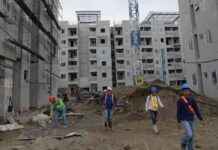Amidst the backdrop of uncertainty and turmoil, American farmers find themselves facing an array of challenges that threaten the very foundation of their livelihoods. The recent freeze on federal funding announced by the Trump administration in January has sent shockwaves across the agricultural landscape, leaving farmers grappling with a bleak reality as they await reimbursements and contemplate the future of their operations.
In the heart of the Arkansas rice fields, fourth-generation farmer Adam Chappell is caught in a precarious situation. Having shelled out $25,000 of his own money to implement vital conservation practices, such as cover cropping, Chappell now finds himself at the mercy of the U.S. Department of Agriculture. With federal programs that are essential to his farm’s survival hanging in the balance, Chappell’s ability to plan for the upcoming crop season remains in limbo, pushing him to consider abandoning the only vocation he has ever known. “I just don’t know who we can count on and if we can count on them as a whole to get it done,” Chappell laments. “That’s what I’m scared of.”
The reverberations of the funding freeze extend far beyond the borders of Arkansas, reaching all the way to Virginia, where a sustainable farming network that supports small farmers is reeling from the impact. Brent Wills, a livestock producer and program manager at the Virginia Association for Biological Farming, reveals the devastating blow dealt by the freeze on USDA programs that serve as the lifeblood of their organization. With nearly $50,000 in grants hanging in the balance, Wills and his team find themselves scrambling to chart a course forward, uncertain of what the future holds. “It’s pretty devastating,” Wills reflects. “The short-term effects of this are bad enough, but the long-term effects? We can’t even tally that up right now.”
As the funding freeze casts its shadow across the nation, North Carolina beekeeper Ang Roell’s ordeal serves as a poignant reminder of the human toll of this crisis. Still awaiting the $14,500 in emergency funding needed to rebuild after Hurricane Helene decimated their beehives, Roell’s beekeeping operation is facing mounting losses and uncertainty. With more than $45,000 in frozen USDA grants and an additional $100,000 hanging in the balance, Roell is forced to confront the grim reality of reimagining their entire business strategy. “I feel shell-shocked,” Roell confides, encapsulating the profound sense of unease gripping the agricultural community.
Unraveling the Funding Freeze: A Closer Look
Within the labyrinth of USDA programs impacted by the funding freeze, two key categories bear the brunt of the fallout. Grant applications that link agricultural initiatives to diversity, equity, and inclusion efforts find themselves in limbo, alongside programs enacted under the Inflation Reduction Act, which earmarked billions for agricultural endeavors. The freeze, compounded by recent layoffs within the USDA, has left a trail of uncertainty in its wake, leaving farmers and stakeholders in a state of limbo.
Despite court orders demanding the release of funds, agencies have taken a staggered approach, releasing funds in segments rather than in a cohesive manner. While other federal agencies have unfrozen substantial funding, the USDA has proceeded cautiously, citing the need to review programs tied to IRA funds. The slow pace of progress has resulted in terminated contracts and a cloud of uncertainty hanging over climate-smart agriculture initiatives.
In late February, a glimmer of hope emerged as the USDA announced the release of $20 million to farmers awarded grants—an initial step in the right direction, albeit a modest one. Mike Lavender, policy director at the National Sustainable Agriculture Coalition, underscores the stark reality facing farmers, with the released funds representing a mere fraction of the total owed. As the agricultural community awaits further clarity, the future remains shrouded in ambiguity, leaving farmers and stakeholders in a state of limbo.
Amidst Uncertainty: Navigating an Unpredictable Landscape
The unfolding saga of the funding freeze has sent shockwaves through the agricultural community, reverberating far beyond financial losses. Farmers who identify as women, queer individuals, or people of color find themselves navigating treacherous waters, with their contracts and applications under scrutiny. The looming specter of federal directives targeting diversity and inclusion programs has cast a pall over funding prospects, leaving stakeholders grappling with an uncertain future.
Rebecca Wolf, a senior food policy analyst at Food & Water Watch, paints a sobering picture of the broader implications of the funding gridlock. Against the backdrop of an agricultural recession and a landscape marred by economic strife, Wolf foresees a troubling trajectory marked by further consolidation and loss of land ownership. With small and medium-sized farmers bearing the brunt of the freeze, the repercussions are poised to reshape the agricultural landscape in profound ways.
Omanjana Goswami, a soil scientist at the Union of Concerned Scientists, sheds light on the environmental fallout of the funding freeze. As agriculture’s carbon footprint looms large, the absence of conservation practices funded by USDA programs could exacerbate emissions, tipping the scales toward a more environmentally precarious future. The interconnected web of agricultural funding, climate action, and carbon emissions underscores the far-reaching consequences of the funding freeze, transcending financial losses to impact the very fabric of our ecosystem.
The Trump administration’s assault on farmers comes at a critical juncture for American agriculture, with existential threats looming large. Against a backdrop of mounting financial woes, natural disasters, and environmental challenges, farmers find themselves at a crossroads, grappling with an uncertain future. As the funding freeze casts a long shadow over the agricultural landscape, the resilience and fortitude of farmers stand as a testament to the enduring spirit that drives America’s heartland forward.














